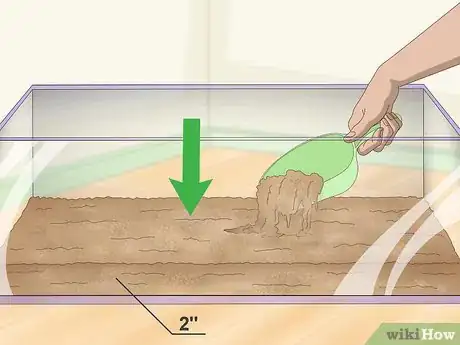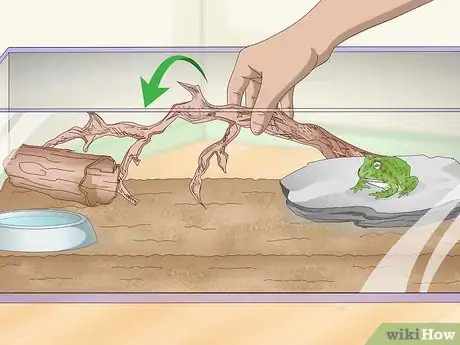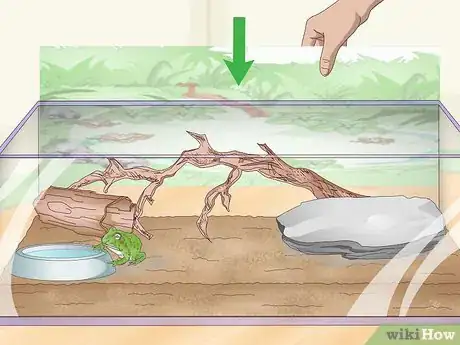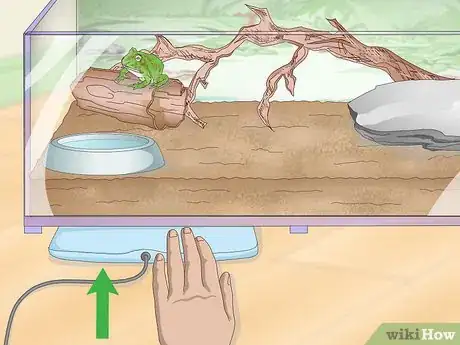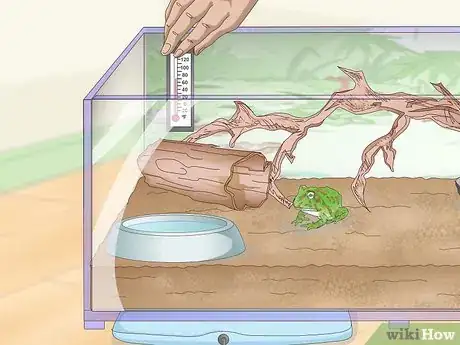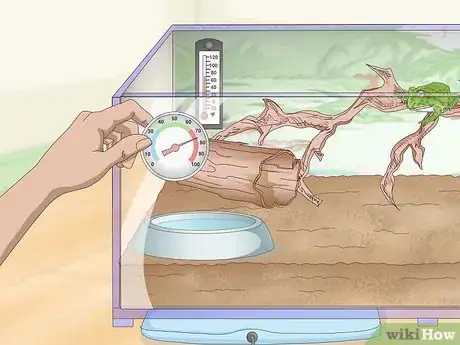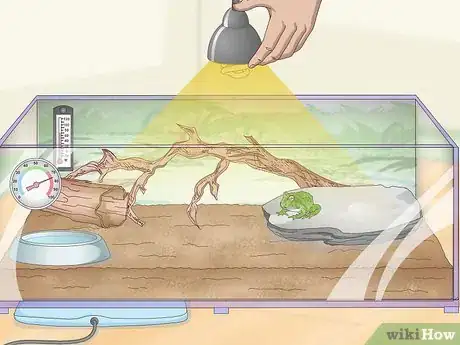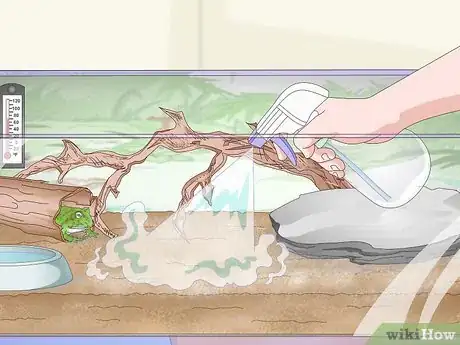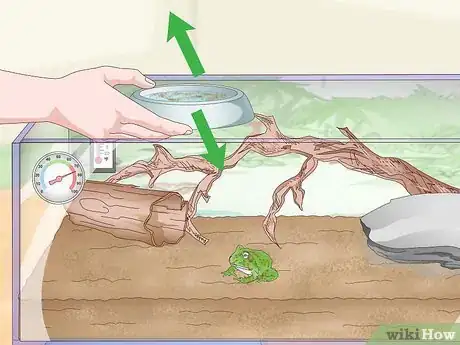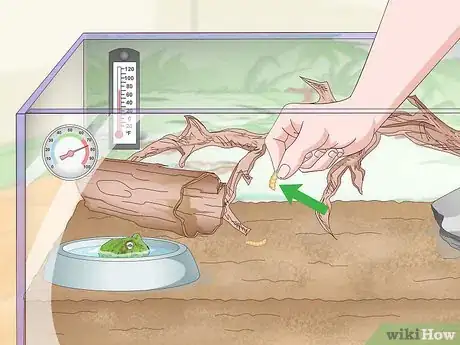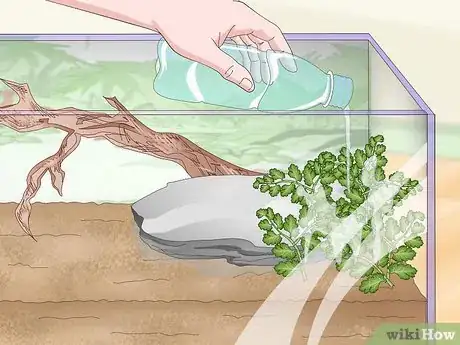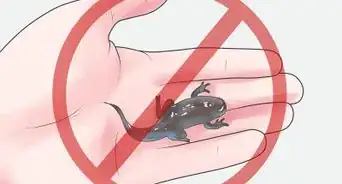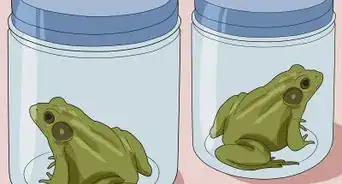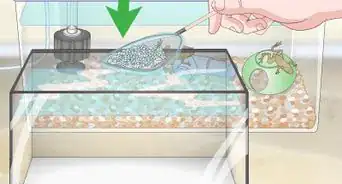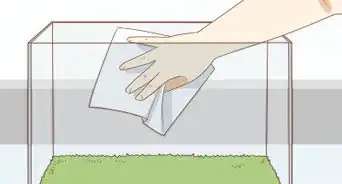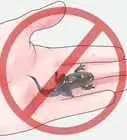This article was co-authored by wikiHow Staff. Our trained team of editors and researchers validate articles for accuracy and comprehensiveness. wikiHow's Content Management Team carefully monitors the work from our editorial staff to ensure that each article is backed by trusted research and meets our high quality standards.
wikiHow marks an article as reader-approved once it receives enough positive feedback. In this case, 88% of readers who voted found the article helpful, earning it our reader-approved status.
This article has been viewed 116,519 times.
Learn more...
The Pacman frog, or the horned frog, is given its name for the small horn-like bumps over its eyes and its ability to open its mouth incredibly wide when catching prey. As it's relatively easy to come by and quite low maintenance, the Pacman frog makes for a great pet for a first-time amphibian owner. By getting a tank with plenty of room, keeping it damp, and making it look like a home for your frog, you can set up a perfect Pacman enclosure for your new pet.
Steps
Setting Up the Enclosure
-
1Purchase at least a 10 US gal (38 L) tank or aquarium. Even though it is a relatively large frog, the Pacman frog prefers to sit and wait for food than spend a lot of time hopping about. Purchase a tank or aquarium that is roughly 20 by 10 by 12 inches (51 by 25 by 30 cm) and has a capacity of 10 gallons (38 L) for your frog.[1]
- Pacman frogs are used to being on the ground rather than moving vertically, so your frog will be more comfortable in a tank that is longer than it is tall.
- Tanks and aquariums should be available online or from your local pet store.
-
2Lay down roughly 2 inches (5.1 cm) of a substrate material. Pacman frogs like to burrow into the ground to sit and wait for something to eat. As such, you’ll need to put down a layer of potting soil, coconut husk fiber, or another soil-like substrate. Purchase the substrate of your choice and pour roughly 2 inches (5.1 cm) over the bottom of the tank.[2]
- Avoid using a substrate that has fertilizers or any other chemical add-ins, as they may hurt your frog.
- If you use substrates made up of sand, gravel, or big pieces of bark, your frog may ingest some while eating. This can lead to choking or indigestion, which could kill your frog.
- If you must use a gravel substrate or something similar, feed your frog with tweezers to reduce the chance of it eating chunks of rock.
Advertisement -
3Add a shallow dish of non-chlorinated water. Your Pacman frog will need to remain moist and damp to stay happy and healthy in its new enclosure. Put a shallow dish in a corner of its enclosure where your frog can sit and be sheltered. Fill the dish with filtered water, bottled water, or water that has been treated with a dechlorination tablet.[3]
- Tap water often has added chlorine and other chemicals which can be harmful to your frog if absorbed. Always use filtered, bottled, or treated water when refilling the water dish.
- Your frog will spend more time sitting in the water than swimming, so make sure the dish is shallow enough that your frog can comfortably sit in it.
-
4Provide logs, branches, and rocks for your frog to climb on. Purchase some artificial or real plants to put in your frog’s enclosure, particularly around the water dish. Add a small log or branch to the tank that your frog can hide or burrow under, or put in a medium-sized rock it can sit on during the day. Place these decorations around the enclosure to decorate it and give your frog places to hide.[4]
- Make sure that you don’t overcrowd the enclosure with decorations. Try and leave around 1/3 of the tank empty so your frog still has room to move around.
-
5Use a rainforest background to make your frog feel more at home. Covering the back and sides of your aquarium will help make the frog feel more enclosed and at home in its tank. Look online or ask at your local aquarium to find a rainforest backdrop for a tank or aquarium. Attach it to the outside of the glass on the sides and back, so that it faces into the tank.[5]
- A background that looks like a rainforest will make your frog feel the most comfortable and at home, but anything green and leafy will work just as well.
- Adding a backdrop will also improve the look of the tank from the outside.
- If you would rather your entire tank be clear glass so that you can see through it, you can skip this step. Adding a background will make the frog more comfortable, but excluding it won’t make its enclosure uninhabitable.
-
6Place a heating pad underneath the tank. Pacman frogs are adjusted to living in temperatures around 70 °F (21 °C) when in the wild, so your frog will need a similarly warm environment in its new enclosure. Place a heating pad underneath the tank and plug it in to begin regulating the temperature.[6]
- Heating pads designed for Pacman frogs and other amphibians should be available online or from your local pet store.
- You should always place the heating pad under the tank, rather than placing it under the substrate. As your toad burrows, it could burrow down far enough to come into contact with the heating pad, and it could suffer a burn.
-
7Attach a thermometer to the side of the tank to monitor its temperature. Purchase a terrarium or tank thermometer and attach to the outside of the glass in a corner of your tank. Check the thermometer at least once each day to make sure the inside of the tank remains around 70 °F (21 °C).[7]
- As your frog can burrow into the substrate or sit in the water to regulate its temperature, some believe you don’t need to worry too much about the temperature. As long as it’s between 60 to 80 °F (16 to 27 °C), your frog should be comfortable.
- Thermometers designed to attach to the glass of a tank or aquarium should be available online or from your local pet store.
-
8Put in a hydrometer to keep an eye on the humidity. A hydrometer will measure the level of humidity inside the tank, which will help determine if it’s within a suitable range for your Pacman frog. Purchase a hydrometer and attach it to the outside of your tank, near the thermometer. Check it regularly the ensure that the tank is humid enough for your frog.[8]
- Pacman frogs go through wetter and drier periods in the wild, so your frog won’t panic too much if the humidity is off. Try and keep the humidity inside the tank around 65%, misting the tank more or less frequently to adjust it if need be.
-
9Add a UVB light to your enclosure. UVB lights may help your frog process calcium and other vitamins, as well as helping any real plants in your enclosure to thrive. Purchase a tank light and fit it with a UVB fluorescent light. Place it over the lid of the tank, and set it on a 12-hour timer so that it doesn’t bother you or your frog at nighttime.
- Some people don’t think that UVB lights help Pacman frogs that much, but at the very least they don’t hurt them. If you want to go the extra mile for your frog, purchase a lamp with a UVB light. Otherwise, you can skip this step and your frog will still be happy and healthy.
Maintaining the Enclosure
-
1Mist the substrate each day to keep it damp, but not wet. Your Pacman frog needs a humid environment in order to live comfortably, as well as damp substrate so that it can burrow into it. Fill a small spray bottle with filtered, bottled, or treated water, and use it to mist the bottom of the tank each morning.[9]
- Mist the substrate just enough to dampen it. Don't soak it, but you also shouldn't allow it to dry out.
-
2Replace the water every time it becomes dirty. If your frog spends a lot of time sitting or soaking in its water dish, the water inside will become dirty very quickly. Check the water each morning, and pour it out if it's looking dirty or muddied in any way. Refill the dish with filtered, bottled, or treated water.
- Make sure you only use water that does not contain chlorine, as even small amounts will be harmful to your frog.
-
3Remove any uneaten food from the enclosure. Pacman frogs only need to be fed 2 to 3 times a week with live insects or worms. At the end of each feeding day, check the enclosure for any food that has gone uneaten. Remove any uneaten food from the tank to prevent it from rotting in your frog's enclosure.
- Use tweezers, feeding tongs, or something similar to remove the uneaten food, as your frog may try to bite your fingers otherwise.
-
4Take care of any live plants in the tank. If you decide to use real plants to decorate your frog's tank, you'll need to care for the plants as well as your frog. Check the care instructions on the plants when you buy them to find out how much water they need to survive.
- Some plants will be able to easily draw enough moisture from the damp substrate to stay alive. For other plants, you will need to water them as well as misting the inside of the tank regularly.
- You should also check every week or so to make sure that your frog hasn't dug up the roots of the plants in its enclosure. If they do, you can keep the plants inside buried pots to prevent this in future.
-
5Clean the tank at least once a month. Over time, the glass inside the tank will get grimy and the substrate at the bottom will need to be changed. Take your frog out of the enclosure and put it somewhere safe, before emptying everything else out of the tank. Scrub the glass with clean water, wipe it dry, add in new substrate, and put the decorations back in where they were before.[10]
- You should clean the tank at least once a month, or potentially more often if you notice it becoming dirty a lot sooner.
Community Q&A
-
QuestionShould I get a thermometer?
 Community AnswerYes. It is important to maintain a safe temperature for your frogs.
Community AnswerYes. It is important to maintain a safe temperature for your frogs. -
QuestionDoes anyone know around what decibel range a male fantasy frog croaks in?
 XxmoonhunterCommunity AnswerI believe it is anywhere between 20 and 60 decibels, averaging out to about 40.
XxmoonhunterCommunity AnswerI believe it is anywhere between 20 and 60 decibels, averaging out to about 40. -
QuestionMy Pacman frog lived for about six months. He was albino and was a younger frog. I left for spring break and was gone for about five days. When I returned, my frog was dead. Do you know why this happened?
 Community AnswerYou may have forgotten to feed him, or not left enough water. He also could have been too cold or too hot. Always get someone to look after pets - even if it is a short break.
Community AnswerYou may have forgotten to feed him, or not left enough water. He also could have been too cold or too hot. Always get someone to look after pets - even if it is a short break.
Warnings
- Pacman frogs are carnivorous, so you should only ever keep 1 in a single tank.⧼thumbs_response⧽
- Pacman frogs don’t have teeth, but they do have a very powerful jaw and may try and bite you. Keep your hands out of the tank and away from your frog unless you absolutely need to,⧼thumbs_response⧽
- You’ll need to feed your Pacman frog live prey in order to keep it happy and healthy. If this makes you uncomfortable, a Pacman frog might not be the right choice for you.⧼thumbs_response⧽
References
- ↑ http://www.anapsid.org/ornatacare.html
- ↑ http://amphibiancare.com/2005/06/05/horned-frogs/
- ↑ http://amphibiancare.com/2005/06/05/horned-frogs/
- ↑ https://animals.mom.me/care-pacman-frogs-5626.html
- ↑ http://www.anapsid.org/ornatacare.html
- ↑ http://amphibiancare.com/2005/06/05/horned-frogs/
- ↑ http://www.anapsid.org/ornatacare.html
- ↑ http://www.anapsid.org/ornatacare.html
- ↑ http://amphibiancare.com/2005/06/05/horned-frogs/
About This Article
To set up a Pacman frog enclosure, purchase a 10-gallon aquarium and line the bottom with 2 inches of potting soil or coconut husk fiber. Next, add a shallow dish of non-chlorinated water to the tank. Then, place a few logs, branches, and rocks inside for your frog to climb on. Finally, use a heating pad under the tank to maintain a temperature of 70 °F and fit the tank with a UVB fluorescent light on a 12-hour timer. For tips on maintaining proper humidity in the tank, read on!

